#also winters building is the winter garden atrium!!
Explore tagged Tumblr posts
Note
i went on your toy house thing but some i can’t see some of the characters : ( I’m just trying to find out who winter is and what he has to do with the twins
Ok that’s completely on me, Winter is attached to a bigger profile that also includes their siblings and I had it hidden since I’m still working on them. I didn’t realize it would hide his attached page so sorry about that LOL
I’m currently working on a new ref for her so I don’t have anything to show except for old art, but Winter is Wyatt’s best friend. Winona is also friends with them but its on a more casual level. The twins are the first buildingfolk Winter meets and she quickly latches himself onto them.
Winter is autistic and often struggles with coddling from his siblings, who mean well but tend to annoy her. This leads her to spend a lot of time with the twins, a pair of individuals she feels are finally on the similar wavelength that she is. They help Wyatt come out of his shell and he helps Winter with their various struggles. Winter isn’t one to reveal secrets, let alone talk much, so it’s important to note that Wyatt is the only person he feels entirely comfortable talking to.
I’m planning to finish their ref soon and make a post on @voicesofthegrid but until then I’ll link their TH page below. Thanks again for the interest!
1 note
·
View note
Text
Moncton brewery crafts new beer designed by Artificial Intelligence: 'It gave us a bunch of ideas'
The folks at Moncton's Tire Shack Brewing decided to have a little bit of fun with the future when it came to their latest beer.
They've brewed a beer with the help of Artificial Intelligence (AI) that is available to the public right now.
Brewery co-owner Alan Norman said they used ChatGPT - a language processing tool that uses AI in a human-like way to answer questions - to come up with a recipe for what future beer trends might be like.
"It gave us a bunch of ideas," said Norman.
Norman and his brew master Henry Soares wanted to have something more local so they asked for a New Brunswick example of a beer made with alternative fermentables and herbs.
"So, it said honey. New Brunswick's got a lot of honey and then it said lavender, there are a lot of lavender fields in New Brunswick so you should make a honey lavender saison is basically what it told us," said Norman.
The next step was to ask how to make it and the brew crew got an immediate response.
"I'm talking two seconds and it spits out the recipe," said Norman.
Amazed, Norman then asked for a name for his new beer and once again, got an instant answer.
"Garden Party, that's perfect. Bees, lavender, it kind of made sense," he said.
They then used a different AI program to come up with a label which took about 30 seconds.
The whole process was mind blowing for the team, but Soares said the beer recipe had its flaws.
"Even though the ingredient list was pretty interesting, the numbers still had to be corrected to work for the beer. It would have also been like two per cent beer. No one wants to drink that," laughed Soares. "It still needed some human touch to it, but the suggestions were awesome. The beer turned out great."
Norman said the original recipe would have been too watery and didn't have enough honey, so Soares had to doctor it a bit.
"He was kind of proud of that," said Norman. "He said, 'hey, I know more than the machine, I'm the professional here,' so, man one, machine zero in the brewing sciences part of it."
While everyone is happy with the finished product, Norman and Soares don't envision some dystopian-like future where beer is designed and made by AI without humans.
"No, I don't think so. It's a whole art thing," said Soares. "People want to have the human touch on it so they'll always be that aspect."
Norman knows it's impossible to replace a human in the brewing world.
"Anybody can write a recipe, but then to actually design it and troubleshoot, to actually be hands-on when something goes wrong and to fix that on the fly, that requires years of knowledge and actual hands on and training," said Norman.
AI is currently at the ground-level, Norman said, and it will likely become more of a factor in people’s lives, for better or worse, in the near future.
"AI is kind of here to stay. We just wanted to jump in and get our feet wet and see if we could have some fun in a low-stakes way," he added.
EXPANSION
While Norman is excited about his new beer, he's also in the final stages of a massive renovation project.
The Tire Shack is expanding to a second 5,600 square-foot building right next door to the taproom that will double their beer producing capacity.
It will also be an event space venue for weddings, corporate functions and live music and the upstairs will have a glass atrium four season rooftop patio.
"In the summer, you'll feel like you're in an outdoor space, but it will be covered and protected with the glass, but in the winter it's almost going to have a snow globe vibe to it," said Norman.
The new building will be open some time this summer.
from CTV News - Atlantic https://ift.tt/btHo9TW
0 notes
Text
Gardening
Gardening is the practice of growing and cultivating plants as part of horticulture. In gardens, ornamental plants are often grown for their flowers, foliage, or overall appearance; useful plants, such as root vegetables, leaf vegetables, fruits, and herbs, are grown for consumption, for use as dyes, or for medicinal or cosmetic use.
Gardening ranges in scale from fruit orchards, to long boulevard plantings with one or more different types of shrubs, trees, and herbaceous plants, to residential back gardens including lawns and foundation plantings, all the way to container gardens grown inside or outside. Gardening may be very specialized, with only one type of plant grown, or involve a variety of plants in mixed plantings. It involves an active participation in the growing of plants, and tends to be labor-intensive, which differentiates it from farming or forestry.
Residential gardening takes place near the home, in a space referred to as the garden. Although a garden typically is located on the land near a residence, it may also be located on a roof, in an atrium, on a balcony, in a window box, on a patio or vivarium.
Gardening also takes place in non-residential green areas, such as parks, public or semi-public gardens (botanical gardens or zoological gardens), amusement parks, along transportation corridors, and around tourist attractions and garden hotels. In these situations, a staff of gardeners or groundskeepers maintains the gardens.
Indoor gardening is concerned with the growing of houseplants within a residence or building, in a conservatory, or in a greenhouse. Indoor gardens are sometimes incorporated as part of air conditioning or heating systems. Indoor gardening extends the growing season in the fall and spring and can be used for winter gardening. Native plant gardening is concerned with the use of native plants with or without the intent of creating wildlife habitat. The goal is to create a garden in harmony with, and adapted to a given area. This type of gardening typically reduces water usage, maintenance, and fertilization costs, while increasing native faunal interest. Water gardening is concerned with growing plants adapted to pools and ponds. Bog gardens are also considered a type of water garden. These all require special conditions and considerations. A simple water garden may consist solely of a tub containing the water and plant(s). In aquascaping, a garden is created within an aquarium tank. Container gardening is concerned with growing plants in any type of container either indoors or outdoors. Common containers are pots, hanging baskets, and planters. Container gardening is usually used in atriums and on balconies, patios, and roof tops. Hügelkultur is concerned with growing plants on piles of rotting wood, as a form of raised bed gardening and composting in situ. An English loanword from German, it means “mound garden.” Toby Hemenway, noted permaculture author and teacher, considers wood buried in trenches to also be a form of hugelkultur referred to as a dead wood swale. Hugelkultur is practiced by Sepp Holzer as a method of forest gardening and agroforestry, and by Geoff Lawton as a method of dryland farming and desert greening. When used as a method of disposing of large volumes of waste wood and woody debris, hugelkultur accomplishes carbon sequestration. It is also a form of xeriscaping. Community gardening is a social activity in which an area of land is gardened by a group of people, providing access to fresh produce, herbs, flowers and plants as well as access to satisfying labor, neighborhood improvement, sense of community and connection to the environment. Community gardens are typically owned in trust by local governments or nonprofits. Garden sharing partners landowners with gardeners in need of land. These shared gardens, typically front or back yards, are usually used to produce food that is divided between the two parties. Organic gardening uses natural, sustainable methods, fertilizers and pesticides to grow non-genetically modified crops. Biodynamic gardening or biodynamic agriculture is similar to organic gardening, but includes various esoteric concepts drawn from the ideas of Rudolf Steiner, such as astrological sowing and planting calendar and particular field and compost preparations. Commercial gardening is a more intensive type of gardening that involves the production of vegetables, nontropical fruits, and flowers from local farmers. Commercial gardening began because farmers would sell locally to stop food from spoiling faster because of the transportation of goods from a far distance. Mediterranean agriculture is also a common practice that commercial gardeners use. Mediterranean agriculture is the practice of cultivating animals such as sheep to help weed and provide manure for vine crops, grains, or citrus. Gardeners can easily train these animals to not eat the actual plant.
0 notes
Text
Gardening
Gardening is the practice of growing and cultivating plants as part of horticulture. In gardens, ornamental plants are often grown for their flowers, foliage, or overall appearance; useful plants, such as root vegetables, leaf vegetables, fruits, and herbs, are grown for consumption, for use as dyes, or for medicinal or cosmetic use.
Gardening ranges in scale from fruit orchards, to long boulevard plantings with one or more different types of shrubs, trees, and herbaceous plants, to residential back gardens including lawns and foundation plantings, all the way to container gardens grown inside or outside. Gardening may be very specialized, with only one type of plant grown, or involve a variety of plants in mixed plantings. It involves an active participation in the growing of plants, and tends to be labor-intensive, which differentiates it from farming or forestry.
Residential gardening takes place near the home, in a space referred to as the garden. Although a garden typically is located on the land near a residence, it may also be located on a roof, in an atrium, on a balcony, in a window box, on a patio or vivarium.
Gardening also takes place in non-residential green areas, such as parks, public or semi-public gardens (botanical gardens or zoological gardens), amusement parks, along transportation corridors, and around tourist attractions and garden hotels. In these situations, a staff of gardeners or groundskeepers maintains the gardens.
Indoor gardening is concerned with the growing of houseplants within a residence or building, in a conservatory, or in a greenhouse. Indoor gardens are sometimes incorporated as part of air conditioning or heating systems. Indoor gardening extends the growing season in the fall and spring and can be used for winter gardening. Native plant gardening is concerned with the use of native plants with or without the intent of creating wildlife habitat. The goal is to create a garden in harmony with, and adapted to a given area. This type of gardening typically reduces water usage, maintenance, and fertilization costs, while increasing native faunal interest. Water gardening is concerned with growing plants adapted to pools and ponds. Bog gardens are also considered a type of water garden. These all require special conditions and considerations. A simple water garden may consist solely of a tub containing the water and plant(s). In aquascaping, a garden is created within an aquarium tank. Container gardening is concerned with growing plants in any type of container either indoors or outdoors. Common containers are pots, hanging baskets, and planters. Container gardening is usually used in atriums and on balconies, patios, and roof tops. Hügelkultur is concerned with growing plants on piles of rotting wood, as a form of raised bed gardening and composting in situ. An English loanword from German, it means “mound garden.” Toby Hemenway, noted permaculture author and teacher, considers wood buried in trenches to also be a form of hugelkultur referred to as a dead wood swale. Hugelkultur is practiced by Sepp Holzer as a method of forest gardening and agroforestry, and by Geoff Lawton as a method of dryland farming and desert greening. When used as a method of disposing of large volumes of waste wood and woody debris, hugelkultur accomplishes carbon sequestration. It is also a form of xeriscaping. Community gardening is a social activity in which an area of land is gardened by a group of people, providing access to fresh produce, herbs, flowers and plants as well as access to satisfying labor, neighborhood improvement, sense of community and connection to the environment. Community gardens are typically owned in trust by local governments or nonprofits. Garden sharing partners landowners with gardeners in need of land. These shared gardens, typically front or back yards, are usually used to produce food that is divided between the two parties. Organic gardening uses natural, sustainable methods, fertilizers and pesticides to grow non-genetically modified crops. Biodynamic gardening or biodynamic agriculture is similar to organic gardening, but includes various esoteric concepts drawn from the ideas of Rudolf Steiner, such as astrological sowing and planting calendar and particular field and compost preparations. Commercial gardening is a more intensive type of gardening that involves the production of vegetables, nontropical fruits, and flowers from local farmers. Commercial gardening began because farmers would sell locally to stop food from spoiling faster because of the transportation of goods from a far distance. Mediterranean agriculture is also a common practice that commercial gardeners use. Mediterranean agriculture is the practice of cultivating animals such as sheep to help weed and provide manure for vine crops, grains, or citrus. Gardeners can easily train these animals to not eat the actual plant.
0 notes
Text
Gardening
Gardening is the practice of growing and cultivating plants as part of horticulture. In gardens, ornamental plants are often grown for their flowers, foliage, or overall appearance; useful plants, such as root vegetables, leaf vegetables, fruits, and herbs, are grown for consumption, for use as dyes, or for medicinal or cosmetic use.
Gardening ranges in scale from fruit orchards, to long boulevard plantings with one or more different types of shrubs, trees, and herbaceous plants, to residential back gardens including lawns and foundation plantings, all the way to container gardens grown inside or outside. Gardening may be very specialized, with only one type of plant grown, or involve a variety of plants in mixed plantings. It involves an active participation in the growing of plants, and tends to be labor-intensive, which differentiates it from farming or forestry.
Residential gardening takes place near the home, in a space referred to as the garden. Although a garden typically is located on the land near a residence, it may also be located on a roof, in an atrium, on a balcony, in a window box, on a patio or vivarium.
Gardening also takes place in non-residential green areas, such as parks, public or semi-public gardens (botanical gardens or zoological gardens), amusement parks, along transportation corridors, and around tourist attractions and garden hotels. In these situations, a staff of gardeners or groundskeepers maintains the gardens.
Indoor gardening is concerned with the growing of houseplants within a residence or building, in a conservatory, or in a greenhouse. Indoor gardens are sometimes incorporated as part of air conditioning or heating systems. Indoor gardening extends the growing season in the fall and spring and can be used for winter gardening. Native plant gardening is concerned with the use of native plants with or without the intent of creating wildlife habitat. The goal is to create a garden in harmony with, and adapted to a given area. This type of gardening typically reduces water usage, maintenance, and fertilization costs, while increasing native faunal interest. Water gardening is concerned with growing plants adapted to pools and ponds. Bog gardens are also considered a type of water garden. These all require special conditions and considerations. A simple water garden may consist solely of a tub containing the water and plant(s). In aquascaping, a garden is created within an aquarium tank. Container gardening is concerned with growing plants in any type of container either indoors or outdoors. Common containers are pots, hanging baskets, and planters. Container gardening is usually used in atriums and on balconies, patios, and roof tops. Hügelkultur is concerned with growing plants on piles of rotting wood, as a form of raised bed gardening and composting in situ. An English loanword from German, it means “mound garden.” Toby Hemenway, noted permaculture author and teacher, considers wood buried in trenches to also be a form of hugelkultur referred to as a dead wood swale. Hugelkultur is practiced by Sepp Holzer as a method of forest gardening and agroforestry, and by Geoff Lawton as a method of dryland farming and desert greening. When used as a method of disposing of large volumes of waste wood and woody debris, hugelkultur accomplishes carbon sequestration. It is also a form of xeriscaping. Community gardening is a social activity in which an area of land is gardened by a group of people, providing access to fresh produce, herbs, flowers and plants as well as access to satisfying labor, neighborhood improvement, sense of community and connection to the environment. Community gardens are typically owned in trust by local governments or nonprofits. Garden sharing partners landowners with gardeners in need of land. These shared gardens, typically front or back yards, are usually used to produce food that is divided between the two parties. Organic gardening uses natural, sustainable methods, fertilizers and pesticides to grow non-genetically modified crops. Biodynamic gardening or biodynamic agriculture is similar to organic gardening, but includes various esoteric concepts drawn from the ideas of Rudolf Steiner, such as astrological sowing and planting calendar and particular field and compost preparations. Commercial gardening is a more intensive type of gardening that involves the production of vegetables, nontropical fruits, and flowers from local farmers. Commercial gardening began because farmers would sell locally to stop food from spoiling faster because of the transportation of goods from a far distance. Mediterranean agriculture is also a common practice that commercial gardeners use. Mediterranean agriculture is the practice of cultivating animals such as sheep to help weed and provide manure for vine crops, grains, or citrus. Gardeners can easily train these animals to not eat the actual plant.
0 notes
Text
Gardening
Gardening is the practice of growing and cultivating plants as part of horticulture. In gardens, ornamental plants are often grown for their flowers, foliage, or overall appearance; useful plants, such as root vegetables, leaf vegetables, fruits, and herbs, are grown for consumption, for use as dyes, or for medicinal or cosmetic use.
Gardening ranges in scale from fruit orchards, to long boulevard plantings with one or more different types of shrubs, trees, and herbaceous plants, to residential back gardens including lawns and foundation plantings, all the way to container gardens grown inside or outside. Gardening may be very specialized, with only one type of plant grown, or involve a variety of plants in mixed plantings. It involves an active participation in the growing of plants, and tends to be labor-intensive, which differentiates it from farming or forestry.
Residential gardening takes place near the home, in a space referred to as the garden. Although a garden typically is located on the land near a residence, it may also be located on a roof, in an atrium, on a balcony, in a window box, on a patio or vivarium.
Gardening also takes place in non-residential green areas, such as parks, public or semi-public gardens (botanical gardens or zoological gardens), amusement parks, along transportation corridors, and around tourist attractions and garden hotels. In these situations, a staff of gardeners or groundskeepers maintains the gardens.
Indoor gardening is concerned with the growing of houseplants within a residence or building, in a conservatory, or in a greenhouse. Indoor gardens are sometimes incorporated as part of air conditioning or heating systems. Indoor gardening extends the growing season in the fall and spring and can be used for winter gardening. Native plant gardening is concerned with the use of native plants with or without the intent of creating wildlife habitat. The goal is to create a garden in harmony with, and adapted to a given area. This type of gardening typically reduces water usage, maintenance, and fertilization costs, while increasing native faunal interest. Water gardening is concerned with growing plants adapted to pools and ponds. Bog gardens are also considered a type of water garden. These all require special conditions and considerations. A simple water garden may consist solely of a tub containing the water and plant(s). In aquascaping, a garden is created within an aquarium tank. Container gardening is concerned with growing plants in any type of container either indoors or outdoors. Common containers are pots, hanging baskets, and planters. Container gardening is usually used in atriums and on balconies, patios, and roof tops. Hügelkultur is concerned with growing plants on piles of rotting wood, as a form of raised bed gardening and composting in situ. An English loanword from German, it means “mound garden.” Toby Hemenway, noted permaculture author and teacher, considers wood buried in trenches to also be a form of hugelkultur referred to as a dead wood swale. Hugelkultur is practiced by Sepp Holzer as a method of forest gardening and agroforestry, and by Geoff Lawton as a method of dryland farming and desert greening. When used as a method of disposing of large volumes of waste wood and woody debris, hugelkultur accomplishes carbon sequestration. It is also a form of xeriscaping. Community gardening is a social activity in which an area of land is gardened by a group of people, providing access to fresh produce, herbs, flowers and plants as well as access to satisfying labor, neighborhood improvement, sense of community and connection to the environment. Community gardens are typically owned in trust by local governments or nonprofits. Garden sharing partners landowners with gardeners in need of land. These shared gardens, typically front or back yards, are usually used to produce food that is divided between the two parties. Organic gardening uses natural, sustainable methods, fertilizers and pesticides to grow non-genetically modified crops. Biodynamic gardening or biodynamic agriculture is similar to organic gardening, but includes various esoteric concepts drawn from the ideas of Rudolf Steiner, such as astrological sowing and planting calendar and particular field and compost preparations. Commercial gardening is a more intensive type of gardening that involves the production of vegetables, nontropical fruits, and flowers from local farmers. Commercial gardening began because farmers would sell locally to stop food from spoiling faster because of the transportation of goods from a far distance. Mediterranean agriculture is also a common practice that commercial gardeners use. Mediterranean agriculture is the practice of cultivating animals such as sheep to help weed and provide manure for vine crops, grains, or citrus. Gardeners can easily train these animals to not eat the actual plant.
0 notes
Text
Gardening
Gardening is the practice of growing and cultivating plants as part of horticulture. In gardens, ornamental plants are often grown for their flowers, foliage, or overall appearance; useful plants, such as root vegetables, leaf vegetables, fruits, and herbs, are grown for consumption, for use as dyes, or for medicinal or cosmetic use.
Gardening ranges in scale from fruit orchards, to long boulevard plantings with one or more different types of shrubs, trees, and herbaceous plants, to residential back gardens including lawns and foundation plantings, all the way to container gardens grown inside or outside. Gardening may be very specialized, with only one type of plant grown, or involve a variety of plants in mixed plantings. It involves an active participation in the growing of plants, and tends to be labor-intensive, which differentiates it from farming or forestry.
Residential gardening takes place near the home, in a space referred to as the garden. Although a garden typically is located on the land near a residence, it may also be located on a roof, in an atrium, on a balcony, in a window box, on a patio or vivarium.
Gardening also takes place in non-residential green areas, such as parks, public or semi-public gardens (botanical gardens or zoological gardens), amusement parks, along transportation corridors, and around tourist attractions and garden hotels. In these situations, a staff of gardeners or groundskeepers maintains the gardens.
Indoor gardening is concerned with the growing of houseplants within a residence or building, in a conservatory, or in a greenhouse. Indoor gardens are sometimes incorporated as part of air conditioning or heating systems. Indoor gardening extends the growing season in the fall and spring and can be used for winter gardening. Native plant gardening is concerned with the use of native plants with or without the intent of creating wildlife habitat. The goal is to create a garden in harmony with, and adapted to a given area. This type of gardening typically reduces water usage, maintenance, and fertilization costs, while increasing native faunal interest. Water gardening is concerned with growing plants adapted to pools and ponds. Bog gardens are also considered a type of water garden. These all require special conditions and considerations. A simple water garden may consist solely of a tub containing the water and plant(s). In aquascaping, a garden is created within an aquarium tank. Container gardening is concerned with growing plants in any type of container either indoors or outdoors. Common containers are pots, hanging baskets, and planters. Container gardening is usually used in atriums and on balconies, patios, and roof tops. Hügelkultur is concerned with growing plants on piles of rotting wood, as a form of raised bed gardening and composting in situ. An English loanword from German, it means “mound garden.” Toby Hemenway, noted permaculture author and teacher, considers wood buried in trenches to also be a form of hugelkultur referred to as a dead wood swale. Hugelkultur is practiced by Sepp Holzer as a method of forest gardening and agroforestry, and by Geoff Lawton as a method of dryland farming and desert greening. When used as a method of disposing of large volumes of waste wood and woody debris, hugelkultur accomplishes carbon sequestration. It is also a form of xeriscaping. Community gardening is a social activity in which an area of land is gardened by a group of people, providing access to fresh produce, herbs, flowers and plants as well as access to satisfying labor, neighborhood improvement, sense of community and connection to the environment. Community gardens are typically owned in trust by local governments or nonprofits. Garden sharing partners landowners with gardeners in need of land. These shared gardens, typically front or back yards, are usually used to produce food that is divided between the two parties. Organic gardening uses natural, sustainable methods, fertilizers and pesticides to grow non-genetically modified crops. Biodynamic gardening or biodynamic agriculture is similar to organic gardening, but includes various esoteric concepts drawn from the ideas of Rudolf Steiner, such as astrological sowing and planting calendar and particular field and compost preparations. Commercial gardening is a more intensive type of gardening that involves the production of vegetables, nontropical fruits, and flowers from local farmers. Commercial gardening began because farmers would sell locally to stop food from spoiling faster because of the transportation of goods from a far distance. Mediterranean agriculture is also a common practice that commercial gardeners use. Mediterranean agriculture is the practice of cultivating animals such as sheep to help weed and provide manure for vine crops, grains, or citrus. Gardeners can easily train these animals to not eat the actual plant.
0 notes
Text
Gardening
Gardening is the practice of growing and cultivating plants as part of horticulture. In gardens, ornamental plants are often grown for their flowers, foliage, or overall appearance; useful plants, such as root vegetables, leaf vegetables, fruits, and herbs, are grown for consumption, for use as dyes, or for medicinal or cosmetic use.
Gardening ranges in scale from fruit orchards, to long boulevard plantings with one or more different types of shrubs, trees, and herbaceous plants, to residential back gardens including lawns and foundation plantings, all the way to container gardens grown inside or outside. Gardening may be very specialized, with only one type of plant grown, or involve a variety of plants in mixed plantings. It involves an active participation in the growing of plants, and tends to be labor-intensive, which differentiates it from farming or forestry.
Residential gardening takes place near the home, in a space referred to as the garden. Although a garden typically is located on the land near a residence, it may also be located on a roof, in an atrium, on a balcony, in a window box, on a patio or vivarium.
Gardening also takes place in non-residential green areas, such as parks, public or semi-public gardens (botanical gardens or zoological gardens), amusement parks, along transportation corridors, and around tourist attractions and garden hotels. In these situations, a staff of gardeners or groundskeepers maintains the gardens.
Indoor gardening is concerned with the growing of houseplants within a residence or building, in a conservatory, or in a greenhouse. Indoor gardens are sometimes incorporated as part of air conditioning or heating systems. Indoor gardening extends the growing season in the fall and spring and can be used for winter gardening. Native plant gardening is concerned with the use of native plants with or without the intent of creating wildlife habitat. The goal is to create a garden in harmony with, and adapted to a given area. This type of gardening typically reduces water usage, maintenance, and fertilization costs, while increasing native faunal interest. Water gardening is concerned with growing plants adapted to pools and ponds. Bog gardens are also considered a type of water garden. These all require special conditions and considerations. A simple water garden may consist solely of a tub containing the water and plant(s). In aquascaping, a garden is created within an aquarium tank. Container gardening is concerned with growing plants in any type of container either indoors or outdoors. Common containers are pots, hanging baskets, and planters. Container gardening is usually used in atriums and on balconies, patios, and roof tops. Hügelkultur is concerned with growing plants on piles of rotting wood, as a form of raised bed gardening and composting in situ. An English loanword from German, it means “mound garden.” Toby Hemenway, noted permaculture author and teacher, considers wood buried in trenches to also be a form of hugelkultur referred to as a dead wood swale. Hugelkultur is practiced by Sepp Holzer as a method of forest gardening and agroforestry, and by Geoff Lawton as a method of dryland farming and desert greening. When used as a method of disposing of large volumes of waste wood and woody debris, hugelkultur accomplishes carbon sequestration. It is also a form of xeriscaping. Community gardening is a social activity in which an area of land is gardened by a group of people, providing access to fresh produce, herbs, flowers and plants as well as access to satisfying labor, neighborhood improvement, sense of community and connection to the environment. Community gardens are typically owned in trust by local governments or nonprofits. Garden sharing partners landowners with gardeners in need of land. These shared gardens, typically front or back yards, are usually used to produce food that is divided between the two parties. Organic gardening uses natural, sustainable methods, fertilizers and pesticides to grow non-genetically modified crops. Biodynamic gardening or biodynamic agriculture is similar to organic gardening, but includes various esoteric concepts drawn from the ideas of Rudolf Steiner, such as astrological sowing and planting calendar and particular field and compost preparations. Commercial gardening is a more intensive type of gardening that involves the production of vegetables, nontropical fruits, and flowers from local farmers. Commercial gardening began because farmers would sell locally to stop food from spoiling faster because of the transportation of goods from a far distance. Mediterranean agriculture is also a common practice that commercial gardeners use. Mediterranean agriculture is the practice of cultivating animals such as sheep to help weed and provide manure for vine crops, grains, or citrus. Gardeners can easily train these animals to not eat the actual plant.
0 notes
Text
Gardening
Gardening is the practice of growing and cultivating plants as part of horticulture. In gardens, ornamental plants are often grown for their flowers, foliage, or overall appearance; useful plants, such as root vegetables, leaf vegetables, fruits, and herbs, are grown for consumption, for use as dyes, or for medicinal or cosmetic use.
Gardening ranges in scale from fruit orchards, to long boulevard plantings with one or more different types of shrubs, trees, and herbaceous plants, to residential back gardens including lawns and foundation plantings, all the way to container gardens grown inside or outside. Gardening may be very specialized, with only one type of plant grown, or involve a variety of plants in mixed plantings. It involves an active participation in the growing of plants, and tends to be labor-intensive, which differentiates it from farming or forestry.
Residential gardening takes place near the home, in a space referred to as the garden. Although a garden typically is located on the land near a residence, it may also be located on a roof, in an atrium, on a balcony, in a window box, on a patio or vivarium.
Gardening also takes place in non-residential green areas, such as parks, public or semi-public gardens (botanical gardens or zoological gardens), amusement parks, along transportation corridors, and around tourist attractions and garden hotels. In these situations, a staff of gardeners or groundskeepers maintains the gardens.
Indoor gardening is concerned with the growing of houseplants within a residence or building, in a conservatory, or in a greenhouse. Indoor gardens are sometimes incorporated as part of air conditioning or heating systems. Indoor gardening extends the growing season in the fall and spring and can be used for winter gardening. Native plant gardening is concerned with the use of native plants with or without the intent of creating wildlife habitat. The goal is to create a garden in harmony with, and adapted to a given area. This type of gardening typically reduces water usage, maintenance, and fertilization costs, while increasing native faunal interest. Water gardening is concerned with growing plants adapted to pools and ponds. Bog gardens are also considered a type of water garden. These all require special conditions and considerations. A simple water garden may consist solely of a tub containing the water and plant(s). In aquascaping, a garden is created within an aquarium tank. Container gardening is concerned with growing plants in any type of container either indoors or outdoors. Common containers are pots, hanging baskets, and planters. Container gardening is usually used in atriums and on balconies, patios, and roof tops. Hügelkultur is concerned with growing plants on piles of rotting wood, as a form of raised bed gardening and composting in situ. An English loanword from German, it means “mound garden.” Toby Hemenway, noted permaculture author and teacher, considers wood buried in trenches to also be a form of hugelkultur referred to as a dead wood swale. Hugelkultur is practiced by Sepp Holzer as a method of forest gardening and agroforestry, and by Geoff Lawton as a method of dryland farming and desert greening. When used as a method of disposing of large volumes of waste wood and woody debris, hugelkultur accomplishes carbon sequestration. It is also a form of xeriscaping. Community gardening is a social activity in which an area of land is gardened by a group of people, providing access to fresh produce, herbs, flowers and plants as well as access to satisfying labor, neighborhood improvement, sense of community and connection to the environment. Community gardens are typically owned in trust by local governments or nonprofits. Garden sharing partners landowners with gardeners in need of land. These shared gardens, typically front or back yards, are usually used to produce food that is divided between the two parties. Organic gardening uses natural, sustainable methods, fertilizers and pesticides to grow non-genetically modified crops. Biodynamic gardening or biodynamic agriculture is similar to organic gardening, but includes various esoteric concepts drawn from the ideas of Rudolf Steiner, such as astrological sowing and planting calendar and particular field and compost preparations. Commercial gardening is a more intensive type of gardening that involves the production of vegetables, nontropical fruits, and flowers from local farmers. Commercial gardening began because farmers would sell locally to stop food from spoiling faster because of the transportation of goods from a far distance. Mediterranean agriculture is also a common practice that commercial gardeners use. Mediterranean agriculture is the practice of cultivating animals such as sheep to help weed and provide manure for vine crops, grains, or citrus. Gardeners can easily train these animals to not eat the actual plant.
0 notes
Text
Gardening
Gardening is the practice of growing and cultivating plants as part of horticulture. In gardens, ornamental plants are often grown for their flowers, foliage, or overall appearance; useful plants, such as root vegetables, leaf vegetables, fruits, and herbs, are grown for consumption, for use as dyes, or for medicinal or cosmetic use.
Gardening ranges in scale from fruit orchards, to long boulevard plantings with one or more different types of shrubs, trees, and herbaceous plants, to residential back gardens including lawns and foundation plantings, all the way to container gardens grown inside or outside. Gardening may be very specialized, with only one type of plant grown, or involve a variety of plants in mixed plantings. It involves an active participation in the growing of plants, and tends to be labor-intensive, which differentiates it from farming or forestry.
Residential gardening takes place near the home, in a space referred to as the garden. Although a garden typically is located on the land near a residence, it may also be located on a roof, in an atrium, on a balcony, in a window box, on a patio or vivarium.
Gardening also takes place in non-residential green areas, such as parks, public or semi-public gardens (botanical gardens or zoological gardens), amusement parks, along transportation corridors, and around tourist attractions and garden hotels. In these situations, a staff of gardeners or groundskeepers maintains the gardens.
Indoor gardening is concerned with the growing of houseplants within a residence or building, in a conservatory, or in a greenhouse. Indoor gardens are sometimes incorporated as part of air conditioning or heating systems. Indoor gardening extends the growing season in the fall and spring and can be used for winter gardening. Native plant gardening is concerned with the use of native plants with or without the intent of creating wildlife habitat. The goal is to create a garden in harmony with, and adapted to a given area. This type of gardening typically reduces water usage, maintenance, and fertilization costs, while increasing native faunal interest. Water gardening is concerned with growing plants adapted to pools and ponds. Bog gardens are also considered a type of water garden. These all require special conditions and considerations. A simple water garden may consist solely of a tub containing the water and plant(s). In aquascaping, a garden is created within an aquarium tank. Container gardening is concerned with growing plants in any type of container either indoors or outdoors. Common containers are pots, hanging baskets, and planters. Container gardening is usually used in atriums and on balconies, patios, and roof tops. Hügelkultur is concerned with growing plants on piles of rotting wood, as a form of raised bed gardening and composting in situ. An English loanword from German, it means “mound garden.” Toby Hemenway, noted permaculture author and teacher, considers wood buried in trenches to also be a form of hugelkultur referred to as a dead wood swale. Hugelkultur is practiced by Sepp Holzer as a method of forest gardening and agroforestry, and by Geoff Lawton as a method of dryland farming and desert greening. When used as a method of disposing of large volumes of waste wood and woody debris, hugelkultur accomplishes carbon sequestration. It is also a form of xeriscaping. Community gardening is a social activity in which an area of land is gardened by a group of people, providing access to fresh produce, herbs, flowers and plants as well as access to satisfying labor, neighborhood improvement, sense of community and connection to the environment. Community gardens are typically owned in trust by local governments or nonprofits. Garden sharing partners landowners with gardeners in need of land. These shared gardens, typically front or back yards, are usually used to produce food that is divided between the two parties. Organic gardening uses natural, sustainable methods, fertilizers and pesticides to grow non-genetically modified crops. Biodynamic gardening or biodynamic agriculture is similar to organic gardening, but includes various esoteric concepts drawn from the ideas of Rudolf Steiner, such as astrological sowing and planting calendar and particular field and compost preparations. Commercial gardening is a more intensive type of gardening that involves the production of vegetables, nontropical fruits, and flowers from local farmers. Commercial gardening began because farmers would sell locally to stop food from spoiling faster because of the transportation of goods from a far distance. Mediterranean agriculture is also a common practice that commercial gardeners use. Mediterranean agriculture is the practice of cultivating animals such as sheep to help weed and provide manure for vine crops, grains, or citrus. Gardeners can easily train these animals to not eat the actual plant.
0 notes
Text
Gardening
Gardening is the practice of growing and cultivating plants as part of horticulture. In gardens, ornamental plants are often grown for their flowers, foliage, or overall appearance; useful plants, such as root vegetables, leaf vegetables, fruits, and herbs, are grown for consumption, for use as dyes, or for medicinal or cosmetic use.
Gardening ranges in scale from fruit orchards, to long boulevard plantings with one or more different types of shrubs, trees, and herbaceous plants, to residential back gardens including lawns and foundation plantings, all the way to container gardens grown inside or outside. Gardening may be very specialized, with only one type of plant grown, or involve a variety of plants in mixed plantings. It involves an active participation in the growing of plants, and tends to be labor-intensive, which differentiates it from farming or forestry.
Residential gardening takes place near the home, in a space referred to as the garden. Although a garden typically is located on the land near a residence, it may also be located on a roof, in an atrium, on a balcony, in a window box, on a patio or vivarium.
Gardening also takes place in non-residential green areas, such as parks, public or semi-public gardens (botanical gardens or zoological gardens), amusement parks, along transportation corridors, and around tourist attractions and garden hotels. In these situations, a staff of gardeners or groundskeepers maintains the gardens.
Indoor gardening is concerned with the growing of houseplants within a residence or building, in a conservatory, or in a greenhouse. Indoor gardens are sometimes incorporated as part of air conditioning or heating systems. Indoor gardening extends the growing season in the fall and spring and can be used for winter gardening. Native plant gardening is concerned with the use of native plants with or without the intent of creating wildlife habitat. The goal is to create a garden in harmony with, and adapted to a given area. This type of gardening typically reduces water usage, maintenance, and fertilization costs, while increasing native faunal interest. Water gardening is concerned with growing plants adapted to pools and ponds. Bog gardens are also considered a type of water garden. These all require special conditions and considerations. A simple water garden may consist solely of a tub containing the water and plant(s). In aquascaping, a garden is created within an aquarium tank. Container gardening is concerned with growing plants in any type of container either indoors or outdoors. Common containers are pots, hanging baskets, and planters. Container gardening is usually used in atriums and on balconies, patios, and roof tops. Hügelkultur is concerned with growing plants on piles of rotting wood, as a form of raised bed gardening and composting in situ. An English loanword from German, it means “mound garden.” Toby Hemenway, noted permaculture author and teacher, considers wood buried in trenches to also be a form of hugelkultur referred to as a dead wood swale. Hugelkultur is practiced by Sepp Holzer as a method of forest gardening and agroforestry, and by Geoff Lawton as a method of dryland farming and desert greening. When used as a method of disposing of large volumes of waste wood and woody debris, hugelkultur accomplishes carbon sequestration. It is also a form of xeriscaping. Community gardening is a social activity in which an area of land is gardened by a group of people, providing access to fresh produce, herbs, flowers and plants as well as access to satisfying labor, neighborhood improvement, sense of community and connection to the environment. Community gardens are typically owned in trust by local governments or nonprofits. Garden sharing partners landowners with gardeners in need of land. These shared gardens, typically front or back yards, are usually used to produce food that is divided between the two parties. Organic gardening uses natural, sustainable methods, fertilizers and pesticides to grow non-genetically modified crops. Biodynamic gardening or biodynamic agriculture is similar to organic gardening, but includes various esoteric concepts drawn from the ideas of Rudolf Steiner, such as astrological sowing and planting calendar and particular field and compost preparations. Commercial gardening is a more intensive type of gardening that involves the production of vegetables, nontropical fruits, and flowers from local farmers. Commercial gardening began because farmers would sell locally to stop food from spoiling faster because of the transportation of goods from a far distance. Mediterranean agriculture is also a common practice that commercial gardeners use. Mediterranean agriculture is the practice of cultivating animals such as sheep to help weed and provide manure for vine crops, grains, or citrus. Gardeners can easily train these animals to not eat the actual plant.
0 notes
Text
Gardening
Gardening is the practice of growing and cultivating plants as part of horticulture. In gardens, ornamental plants are often grown for their flowers, foliage, or overall appearance; useful plants, such as root vegetables, leaf vegetables, fruits, and herbs, are grown for consumption, for use as dyes, or for medicinal or cosmetic use.
Gardening ranges in scale from fruit orchards, to long boulevard plantings with one or more different types of shrubs, trees, and herbaceous plants, to residential back gardens including lawns and foundation plantings, all the way to container gardens grown inside or outside. Gardening may be very specialized, with only one type of plant grown, or involve a variety of plants in mixed plantings. It involves an active participation in the growing of plants, and tends to be labor-intensive, which differentiates it from farming or forestry.
Residential gardening takes place near the home, in a space referred to as the garden. Although a garden typically is located on the land near a residence, it may also be located on a roof, in an atrium, on a balcony, in a window box, on a patio or vivarium.
Gardening also takes place in non-residential green areas, such as parks, public or semi-public gardens (botanical gardens or zoological gardens), amusement parks, along transportation corridors, and around tourist attractions and garden hotels. In these situations, a staff of gardeners or groundskeepers maintains the gardens.
Indoor gardening is concerned with the growing of houseplants within a residence or building, in a conservatory, or in a greenhouse. Indoor gardens are sometimes incorporated as part of air conditioning or heating systems. Indoor gardening extends the growing season in the fall and spring and can be used for winter gardening. Native plant gardening is concerned with the use of native plants with or without the intent of creating wildlife habitat. The goal is to create a garden in harmony with, and adapted to a given area. This type of gardening typically reduces water usage, maintenance, and fertilization costs, while increasing native faunal interest. Water gardening is concerned with growing plants adapted to pools and ponds. Bog gardens are also considered a type of water garden. These all require special conditions and considerations. A simple water garden may consist solely of a tub containing the water and plant(s). In aquascaping, a garden is created within an aquarium tank. Container gardening is concerned with growing plants in any type of container either indoors or outdoors. Common containers are pots, hanging baskets, and planters. Container gardening is usually used in atriums and on balconies, patios, and roof tops. Hügelkultur is concerned with growing plants on piles of rotting wood, as a form of raised bed gardening and composting in situ. An English loanword from German, it means "mound garden." Toby Hemenway, noted permaculture author and teacher, considers wood buried in trenches to also be a form of hugelkultur referred to as a dead wood swale. Hugelkultur is practiced by Sepp Holzer as a method of forest gardening and agroforestry, and by Geoff Lawton as a method of dryland farming and desert greening. When used as a method of disposing of large volumes of waste wood and woody debris, hugelkultur accomplishes carbon sequestration. It is also a form of xeriscaping. Community gardening is a social activity in which an area of land is gardened by a group of people, providing access to fresh produce, herbs, flowers and plants as well as access to satisfying labor, neighborhood improvement, sense of community and connection to the environment. Community gardens are typically owned in trust by local governments or nonprofits. Garden sharing partners landowners with gardeners in need of land. These shared gardens, typically front or back yards, are usually used to produce food that is divided between the two parties. Organic gardening uses natural, sustainable methods, fertilizers and pesticides to grow non-genetically modified crops. Biodynamic gardening or biodynamic agriculture is similar to organic gardening, but includes various esoteric concepts drawn from the ideas of Rudolf Steiner, such as astrological sowing and planting calendar and particular field and compost preparations. Commercial gardening is a more intensive type of gardening that involves the production of vegetables, nontropical fruits, and flowers from local farmers. Commercial gardening began because farmers would sell locally to stop food from spoiling faster because of the transportation of goods from a far distance. Mediterranean agriculture is also a common practice that commercial gardeners use. Mediterranean agriculture is the practice of cultivating animals such as sheep to help weed and provide manure for vine crops, grains, or citrus. Gardeners can easily train these animals to not eat the actual plant.
0 notes
Text
Honor Bound 4 - 18

Honor Bound 4 - 18 (Undeserved Reputation) @badthingshappenbingo
Requested by @whumps-the-word
~
This is a series. Start here, continued from here.
This is a sequel to Honor Bound, Honor Bound 2, Honor Bound 3.
AO3
Cw: past captivity, implied whump of a minor, PTSD, dissoci@tion, death mention
~
Gray smiled gently as they drove, avoiding potholes in the road caused not by violence, but by the simple, innocent freeze and thaw of the ground. The sun was already high in the sky after more than three hours of driving. The sky was clear, the air clean and cool with the northern summer that was already well under way.
Edrissa sat in the passenger seat, almost completely turned around, chattering happily to Vera in the back seat. Every now and then, Gray and Vera met eyes in the rear view, and Gray could read something like gratitude in her gaze.
“…and there’s this store in Crayton that sells three different kinds of lace!” Edrissa said, the wispy blonde bun at the top of her head bobbing along as she spoke. “And there’s a lot of cotton, I mean, obvious, but they also sometimes have some nice linen and I think that’s what I’ll make Sam’s sling out of, so it breathes. Because it gets hotter up here than I thought it would, because I thought it wouldn’t get very hot at all and it’s already May and it’s been pretty warm, and the winter was so cold so I just kind of assumed it would stay cold. I mean, it’s been nice outside. Maybe when it gets a little warmer we can go hang out at the lake, maybe do a picnic, I mean it’s not very far from the house but it’s really pretty and I’ve already been in it and it doesn’t go that deep, but it is really cold. Before that I hadn’t been swimming in so long. But yeah, I think I’ll do the sling out of linen, and I hope they have blue because that’s Sam’s favorite color.”
She paused to take a breath. Vera grinned at her.
“It is Sam’s favorite color,” Vera said, and Gray was tempted to give Vera a conspiratory nudge. “What else have you been up to while we’ve b-been—” Her voice wavered for just a moment. “—gone?”
“Um…” Edrissa’s mouth twisted and she leaned towards Vera. “Yeah, um, a lot. Gray said, Gray said I could paint my room if I wanted, but I haven’t found the right color. They’re all so… so garish.” Edrissa flipped the stray wisps of hair out of her face and looked to Vera, eyebrows raised, as if she was waiting for something.
It was so good to see Edrissa looking for Vera to assure her not that she was safe, but that she was… cool.
“Absolutely,” Vera said with fervor. “Sometimes walls just need to look sophisticated.” Edrissa lifted her chin, and her mouth pulled into a wider smile at the word.
“Exactly,” she said with an emphatic nod. “Sophisticated. I was thinking I could do a whole thing with a mirror on the wall and, and maybe a nice painting if I can find one that captures the… the…” Edrissa stumbled for a moment, her eyes still fixed on Vera. “…the atmosphere I want.”
Sadness dragged at Gray’s heart. She hasn’t been allowed to make her own choices, any choices for two years. And I remember how much I just wanted to be me when I was eighteen.
They pressed their lips into a line to stop the corners of their mouth from falling.
“That sounds like such a great idea,” Vera said, her face breaking into a smile again. “And… Tori and I wanted to start a garden out back. It’s a little late for planting, but… if we get seedlings, would you want something?”
“Yes!” Edrissa cried, and distractedly tapped Gray on the shoulder. For a moment Vera looked at Gray in delighted surprise. Edrissa hadn’t let anyone but Tori and Vera touch her since she’d been rescued almost five months ago. Gray knew the easy touch on their shoulder spoke volumes of the healing she’d done just in the past three weeks.
I wonder how much of that is time away from Gavin. Gray pushed the thought out of their head.
“Oh, my god, I totally forgot. Last time I was in Burmingham, they had little mint plants. Gray said they wanted some, and I forgot!” She turned to Gray with an unsteady smile. “I’m sorry, I—” Edrissa shivered. Her eyes went distant. She curled into herself slightly, shrinking back against the door of the car.
“It’s alright, Edrissa,” Gray said gently, never taking their eyes off the road. “I’m not hurt. I’m not angry. It’s just a mistake, right? Mistakes are alright.”
“Mm-hm,” Edrissa said uncertainly. She relaxed slightly.
“Remember your counting?” Gray said, low and calm.
Edrissa jerked her head in a nod. She took in a deep breath. “One two three four five,” she muttered, and shook out her hands at the wrists with each number.
“Good. Let’s do it again, together.” Gray’s hands were steady on the wheel, never faltering. Watching the pavement of the road disappear under their car.
Edrissa drew in another deep breath. “One two three four five,” she and Gray said together as she shook out her hands, her quavering voice mixing with Gray’s steady one.
“One more time. Deep breath, one two three four five.” This time, Edrissa, Vera, and Gray said it together.
Gray glanced at Edrissa, at how her shoulders hunched just a little more than they had before, at the dullness in her eyes that reminded them so much of… of Vera, when she was under. Their mouth made a hard line.
“S-sorry,” Edrissa murmured. “I j-just…”
“It’s alright, Edrissa,” Gray said evenly, passing the first few houses on the north outskirts of Crayton. “Everyone has moments, and you were just having a moment.”
“Having a moment,” Edrissa said softly. “Just having a moment.” She smiled tightly at Vera, the corners of her mouth twisting in embarrassment.
Gray’s heart ached for Edrissa, for the girl who had just been going on and on about her room and her fabrics not thirty seconds ago and was now trembling, embarrassed, frightened. Vera leaned forward and put her hand palm up on the center console. An invitation, not a demand. Edrissa fit her hand into Vera’s, and Vera squeezed.
“Tell me more about what plants you want.”
Edrissa offered a wider smile. “Um, I like osteospermum,” she said, her eyes shifting down. “And sunflowers. I like the tall kinds of flowers.” She looked up at Vera. “I had to get a book on plants that do okay with the, the climate up here, because down south it was always—” She cut herself off and swallowed hard. “I like the colorful tall kinds of plants. I’d try for a rosebush but I think it’s too hard for this year.”
“Hm.” Vera nodded. “Well, I’d like to try some raspberry and strawberry bushes. And we could build a shade for the garden, in case the sun is too much.”
“Y-yeah,” Edrissa said softly. She sat back slightly in her seat until Gray pulled onto the main street of shops. They eased the car into a spot along the sidewalk. When Gray stopped, Edrissa shook herself slightly and looked up.
Gray put the car in park. “I was thinking you two could get out here,” they said, indicating with their hand the store that had regular deliveries of fabrics. “I should go to the town hall and check in with Daniel Schiester. I understand your check-in was… rushed.”
“And good fucking thing, too,” Vera said quietly, her jaw clenching shut.
Gray dipped their head. “I don’t exactly appreciate the way he’s spoken to you in the past, so I thought I would make this visit alone. Make sure he feels in control of the situation. Stroke his comically over-inflated ego.”
“I swear to god, he’d make a great fucking syndicate leader,” Vera said, rolling her eyes. She opened the door and climbed out, moving stiffly. Edrissa got out, too, and drifted to Vera’s side.
Gray rolled the passenger window down and leaned towards it. “Shouldn’t take longer than twenty minutes. If you move on from here and I don’t catch you, I’ll meet you in the square in an hour, and we can get lunch. Sound like a plan?”
Vera nodded and cocked her eyebrow. “Have fun with DFS,” she said, snidely.
Gray’s brow furrowed. “DFS?”
Vera bent forward and leaned into the car. “Daniel. Fucking. Schiester,” she said, her voice nearly gleeful with contempt.
Gray snorted and leaned back. “Ah. I’ll have to try not to call him that to his face.”
Vera straightened and shrugged. “If you do, get pictures of his reaction.”
Gray laughed and put the car in drive. “See you soon,” they said, and pulled away.
∴
As Gray got closer to the town hall, their hands tightened on the wheel. Something itched in the back of their mind, something about how Daniel looked at Vera with fascination, with humor. As if he was watching a dog performing tricks. Saccharine. Amused.
Something in the back of their mind stirred at how Daniel looked at Gavin.
There was something there, between them. Gray doubted they had ever actually met. Perhaps it was just morbid, spiteful fascination on Daniel’s part, fascination with the syndicates who ruined the lives of the victims he saw every day. Perhaps it was buried rage, resentment that people like Gavin’s family were the reason Crayton had to exist at all.
Perhaps it was something else, though Gray wasn’t sure what.
Gray pulled in front of the town hall and parked the car. They sat quiet in the seat, staring at the front door, already feeling the tension headache starting. They breathed a sigh, turned off the car, and got out.
Inside the atrium it was cool, dark, and empty, just like it almost always was when refugees weren’t being processed. Gray’s hands tightened into fists and they began to climb the stairs to Daniel’s office.
The stairs creaked under Gray’s feet, their footsteps muffled by the dark green carpet. They made their way to the landing and turned in the direction of Daniel’s office. They almost hoped he wasn’t in today. Their hands clenched tighter as they walked down the hallway, almost feeling the urge to tiptoe, to not make any noise.
Gray grimaced. I’m being ridiculous.
They stopped in front of the door to Daniel’s office. They knocked.
“Come in,” came the deep, even voice. Gray’s face fell. They turned the handle and pushed the door open.
Daniel glanced up from his work on his computer, then looked up and pushed himself away from his desk. “Mx. Uriah,” he said, standing, and held out his hand. “Always good to see you.”
Gray’s skin felt cold as they shook Daniel’s hand once.
“Mr. Mayor,” they said stiffly.
“Ah,” Daniel said with a smile. “I suppose if I wanted you to call me by my first name, I should have begun with that courtesy. Forgive me.”
“Old habits, on my end,” Gray said, and forced their mouth into a smile.
“Right.” Daniel sat back into his chair and leaned his elbows on the desk. “What can I help you with?”
Gray had to stop themself from staring at the pictures of refugees on the walls. Those pictures definitely weren’t of every single refugee Daniel had saved, they couldn’t be. There couldn’t have been more than forty or fifty people in those pictures, and Gray knew Crayton could see that many in a busy week. Maybe those refugees held some meaning for Daniel. Gray didn’t want to pry.
If they were perfectly honest with themself, they didn’t want to ask.
“I’m sure at this point that you are aware that my family has returned from the south?” Gray said, meeting Daniel’s eyes.
Daniel grinned. “Ah. Yes. The triumphant heroes return, quite successful, I’m given to understand. Colleen Stormbeck is dead, and the region is destabilized.”
“That’s right,” Gray said. “They were successful, although at great cost to themselves.”
Daniel’s mouth turned down. “You don’t mean that any of them died…?” He turned to rifle through some papers on his desk. “When my people checked them in, all six were—”
“They all came back alive, yes,” Gray said, their heart twinging. Their gaze fell. “But they all came back with some sort of… permanent… mental or physical scarring.”
“Hm.” Daniel leaned back and folded his hands in his lap. “When you say they all came back alive, I’m assuming you’re not including the Stormbeck boy in your count.”
Gray blew out a slow breath. “When he left here, his name was Gavin Uriah.” They raised their gaze to meet Daniel’s, his eyes a cold blue that always seemed to pierce through Gray. “But yes. He is dead.”
Daniel huffed out a silent laugh. “Generous of you to allow him to take your name, considering everything he’s d—”
“I don’t wish to discuss the rehabilitation of Gavin Uriah,” Gray said softly, their cheeks reddening. “I am fully aware of your opinion of him, and of redemption in general. The fact is when he left here, I had become rather fond of him. And I’d like to let his memory remain for me what he was: a broken boy who died trying to set things right.” Gray’s stomach churned.
Daniel was silent for a moment, regarding Gray coolly across his desk. After a long moment he nodded and said, “Just more evidence for the syndicates’ cruelty, then. I’m sorry your family was the target.”
“So am I,” Gray murmured. They glanced around the office and returned their gaze to Daniel. “But they had to check in with your people in the dead of night and move on without proper processing, as one of them was gravely injured. I wanted to make sure nothing was missed, and answer any questions you had.”
“No, nothing was missed,” Daniel said with a winning smile, waving his hand. “I know that your team arrived in no condition to follow protocol, and the people who checked them in are very thorough.”
“Good,” Gray murmured. The hair on the back of their neck tingled. “Did you need anything from me?”
“Actually, I could use your assistance,” Daniel said with a smile. “Due to the instability of the western region, we are already seeing an increase in the frequency and number of refugees, and am very certain that will only continue to increase. Summer is always a busy season for us, but I am anticipating unprecedented numbers. At the moment, I currently don’t have the people to handle this efficiently. Your family is particularly suited to assisting with refugees, given the nature of your work. I was hoping to recruit you in the processing, if you’re able.”
Gray nodded. “Of course. I can’t speak for the others as they are all convalescing, but I would be happy to help. I will pass on the request. I have no doubt they will offer what they can, as soon as they are able to travel. A few of them may be ready now.”
“Whatever you can do will be appreciated,” Daniel said, and stood, offering Gray his hand. Gray took it. “Always a pleasure, Gray. When you and your family are ready we will orient you with our process.”
Gray nodded. “I’ll keep you posted. Until then, stay well, Daniel.”
“Thank you.” Daniel smiled and sat down. He turned back to his work.
Gray turned and left the office, closing the door behind them. They walked down the hall, their steps quickening, their shoulders tightening. They made their way down the stairs and across the atrium. By the time they pushed through the doors out into the sun, they were nearly jogging.
Continued here
@untilthepainstarts, @womping-grounds, @free-2bmee, @quirkykayleetam, @walkingchemicalfire, @inpainandsuffering, @redwingedwhump, @burtlederp, @castielamigos-whump-side-blog, @whatwhumpcomments, @cursedscribbles, @whumpywhumper, @stxck-fxck, @omega-em-z-02, @whumps-the-word, @justwhumpitwhumpitgood, @justplainwhump, @moose-teeth, @slaintetowhump, @finder-of-rings, @inky-whump, @thatsthewhump, @orchidscript, @insanitywishes, @this-mightaswell-happen, @newandfiguringitout, @whumpkitty, @pretty-face-breaker, @cinnamonflavoredhugs, @inaridriscoll, @im-just-here-for-the-whump, @endless-whump
#honor bound 4#bad things happen bingo#undeserved reputation#whump#recovery#past torture#past captivity#Gray: mom friend#edrissa: mystery girl#Edrissa is so soft#implied whump of a minor tw#PTSD tw#grounding exercise#dissociation tw#Daniel fucking Schiester#Daniel Schiester is an asshole#DFS vs. Gray: welcome to the thunderdome#hashtag foreshadowing#Gavin Stormbeck is dead#death mention tw#torture aftermath#my oc: Gray
73 notes
·
View notes
Text
FOMA 33: The Indoor University; Canadian Welfare And Modern Architecture (Part 1)
Starting from the ‘60s, Canada embarked in a massive policy of creation of institutions for higher education as part of a concerted effort of modernization of the country, which, after the end of World War II was increasing its autonomy from the British Empire.

Bata Library, Trent University, Peterborough (1967-1969) by Ronald Thom. | Photo via FIG projects
A survey of the 1965-66 academic year published in October 1966, by the specialized magazine University Affairs listed 22 institutions that were either new (Simon Fraser University, University of Calgary, York University) or had their status modified (Mount Saint Vincent College, for example, became Mount Saint Vincent University and Lakehead College of Arts, Science and Technology became Lakehead University).
Besides providing spaces and services for its citizens, these efforts were also instrumental to reinforce the concept of a country based on two cultures, the anglophone and the francophone, not just present in Quebec, but also to be found across all the country. Moreover, issues of decentralization, in order to bring higher education to all the provinces, were crucial. This massive investment from the federal state and the local administrations meant that universities were (and still are) public entities, a quite different condition if compared to the neighbor at the South of the border.

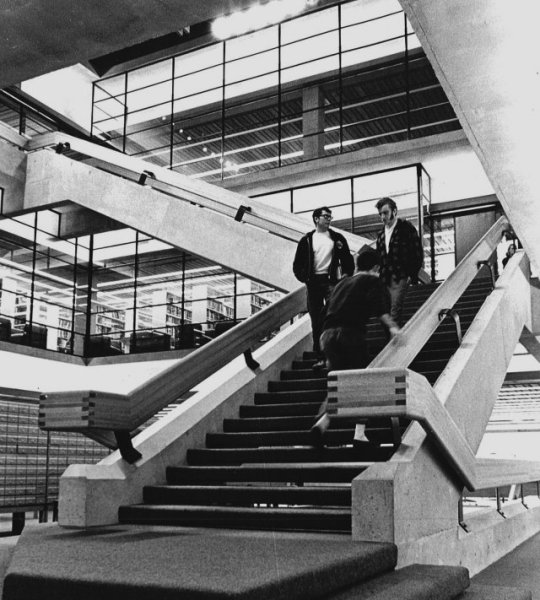
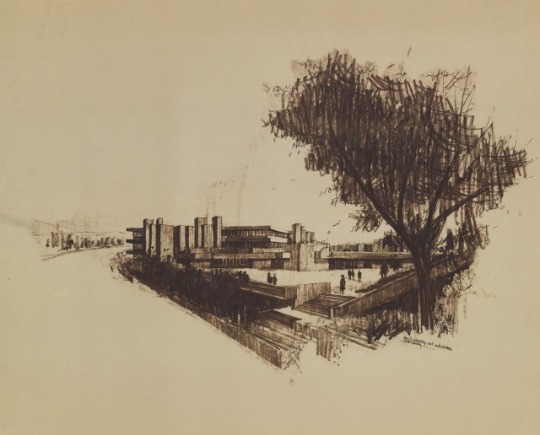
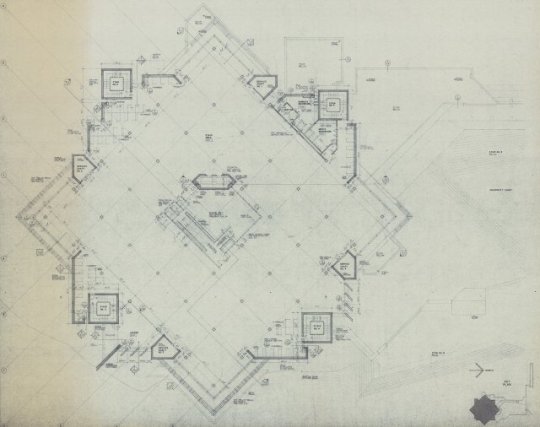

Bata Library, Trent University, Peterborough (1967-1969) by Ronald Thom. | Photo via FIG projects
Ronald Thom designed the masterplan of the Trent University campus in Peterborough and a series of buildings scattered on the premises. The Bata Library was located at the core of the campus, with the intention to become its focal point, dramatically overseeing the Otonabee river. The whole building is organized around a vast lobby that distributes natural light to the surrounding study areas. The walls of Bata are exposed-aggregate rubble and concrete, which Thom saw as matching closely the stone outcroppings of the area.

Scott Library, York University, North York (1968-1971) by John Parkin, John Bonnick, William Greer. | Photo via FIG projects
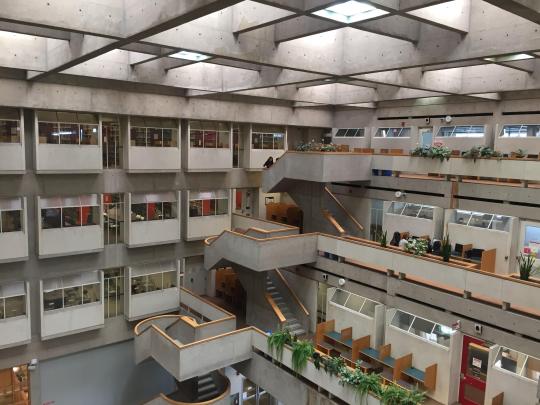
An austere inverted concrete ziqqurat to the outside, the indoors reveals a vast lobby towards which administrative and librarian offices are organized through a system of semi-public terraces with reading spaces. | Photo via FIG projects


Fisher Rare Books Library and Robarts Library, Toronto University (1968-1973) by Warner, Burns, Toan & Lunde. | Photo via FIG projects

Two adjacent buildings, holding the collections of Toronto University; the six floors volume of the Fisher Rare Books Library contains a breathtaking space dedicated to ancient and rare books. | Photo via FIG projects
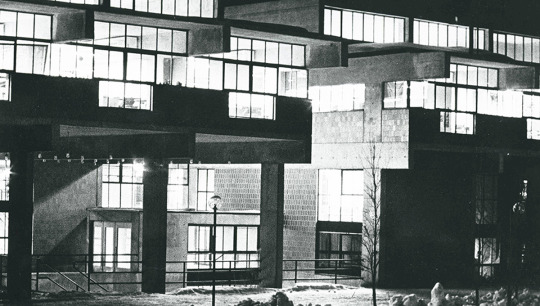

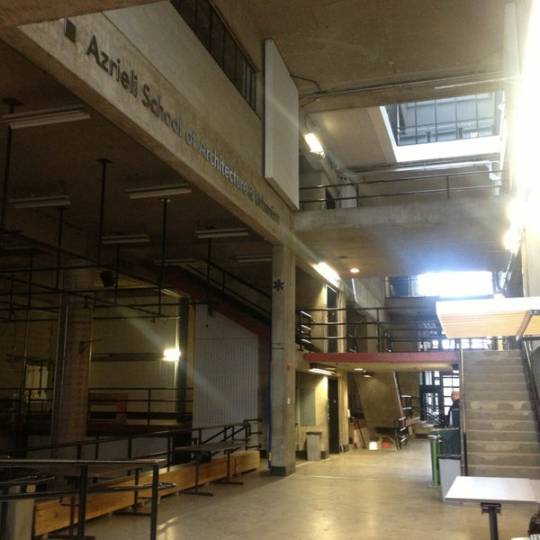
School of Architecture at Carleton University, Ottawa (1968) by Carmin and Eilin Corneil. | Photo via FIG projects
The stacked volumes of the studios and class-rooms are organized around the internal circulation, composed by a vast atrium that crosses the entire building, used as space for exhibition, lectures and students’ presentations. The whole language of the building is almost spartan with concrete and bricks left exposed as in an industrial building, hence underlying the productive nature of architectural studies.

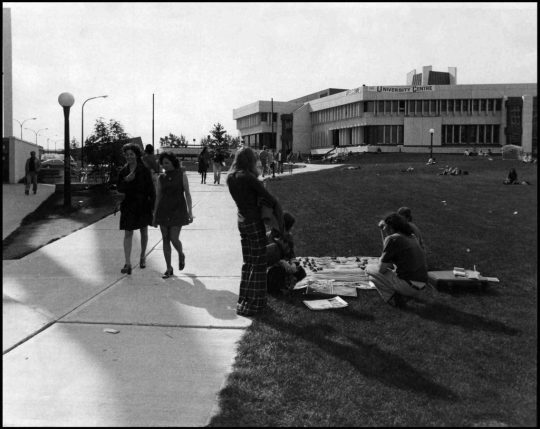
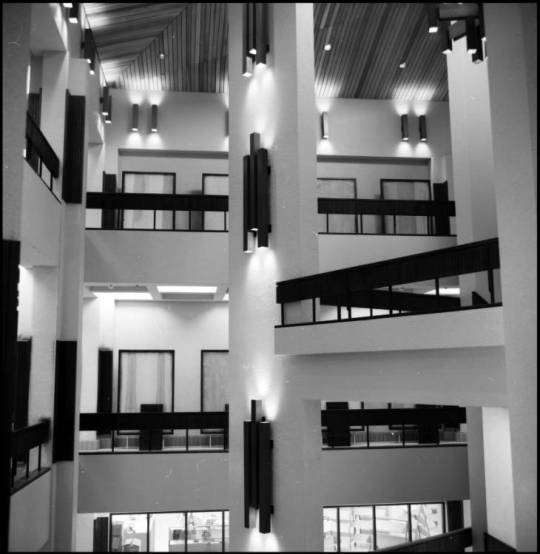

MacEwan Hall, University of Calgary (1967) by Stevenson Raines Barrett. | Photo via FIG projects
The seat of the students union of the new university, which in 1966 became autonomous from the University of Alberta. “In the early 1970s, MacEvan Hall included a food services area that seated 500, pool and ping-pong tables, a bowling alley, a 1,000 person dining room and ballroom, a fire pit lounge, a music lounge, a library, offices and meeting rooms, a bank, a barber, and a bookstore.”
“In the public domain the most important change distinguishing the new universities from the old is that the new universities are in the public domain in a manner, and to a degree, uncommon to the old. It is not simply that they are public institutions initiated and sustained by government grants. This was the case for many universities in the past. But most of the universities begun in the last decade … have stirred a wide interest and a sense of proprietorship in the communities in which they were established. The result is that these universities are in the public domain; not simply as public institutions, but as community projects.
Part of the mystique of the university has been torn away. The old university with its absent-minded professors and its ivy-covered walls is a romantic picture that stirs pleasant memories, but little enthusiasm as a model for today’s development. The new universities are “public property” in a sense that was not true of universities in the past. As a consequence, all aspects of the university’s life and work are being regarded afresh by many people unfamiliar with university traditions. And while these people are not unsympathetic with what they see, they do not hesitate to criticize sharply when they see fit. The university no longer enjoys an isolated and protected position in the community.”
– Murray G. Ross, president, York University, in University Affairs, April 1965.
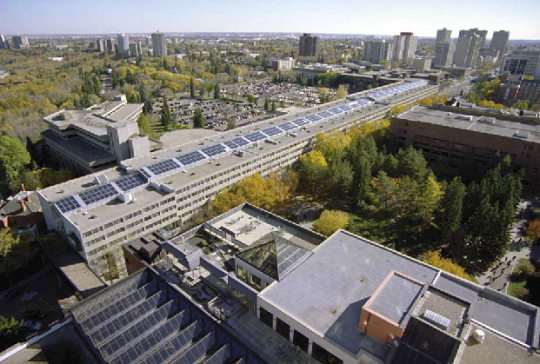
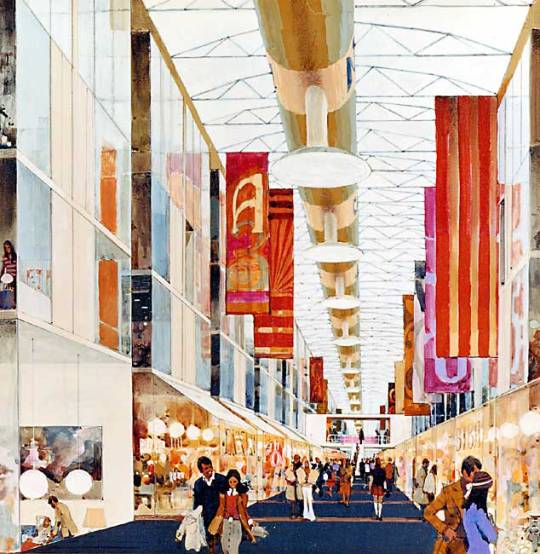

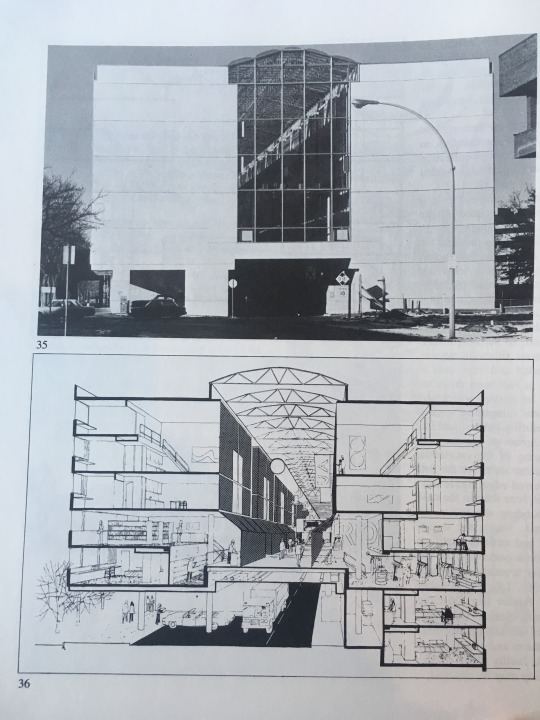
Housing Union Building (HUB), University of Alberta (1969-1971) by Diamond and Myers Architects with R.L. Wilkin. | Photo via Capital Modern
Designed by former Louis Kahn students, The Housing Union Building (HUB) was an innovative experiment in student housing, combining function and circulation in a new way. The elongated building was designed as a weather-enclosed concourse linking to other campus buildings, and as the acronym suggests, was intended to be a central focus on campus for students, staff and the general public.
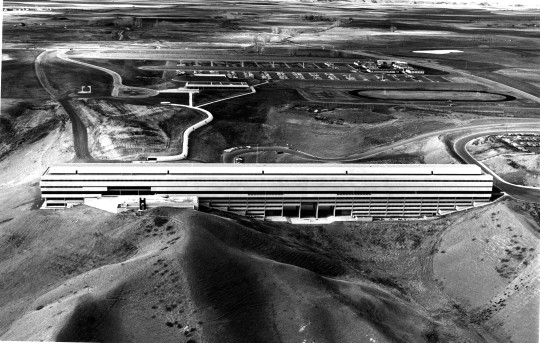


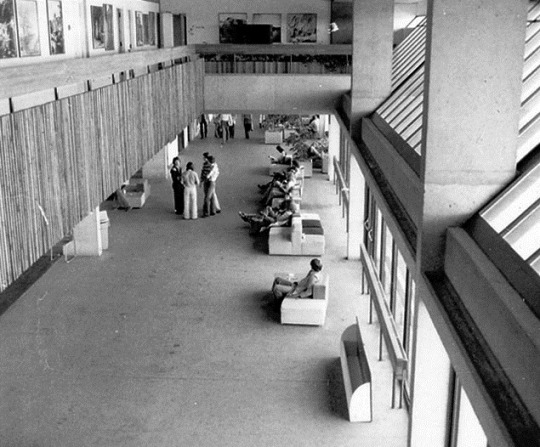

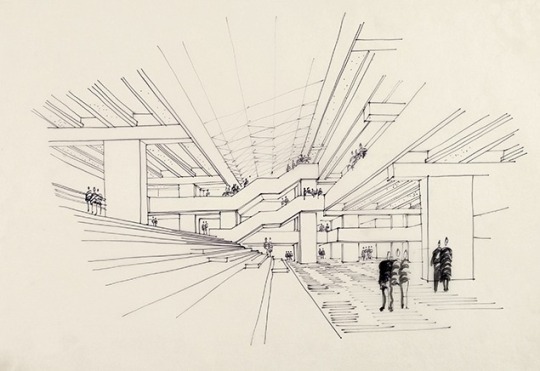

Lethbridge University Hall (1968-1969) by Arthur Erickson. | Photo via University of Lethbridge
Arthur Erickson, perhaps the early prototype of the starchitect, a globe-trotting cosmopolitan designer, created the main hall for the University of Lethbridge, founded in 1967. The elongated building, a land-art megastructure over a ravine, juxtaposed to the horizontal landscape of the prairies was organized along an extended walkway, a six storey concourse with a complex section, conceived as the central element of social gathering, especially during winter.





University Center, University of Manitoba, Winnipeg (1966-1969) by Number Ten Architectural Group. | Photo via Bohemian Blog
University Centre is a five-storey poured and pre-cast concrete structure constructed as part of a campus planning strategy that aimed to develop the campus as an urban centre. Overground facilities include dining space, offices and conference rooms, while the lounges, cafeteria, bookstore and open spaces for gathering were located below grade. University Centre serves as the central meeting point for all of the campus tunnels, culminating in a two-storey multifunctional space referred to as a “campo”.
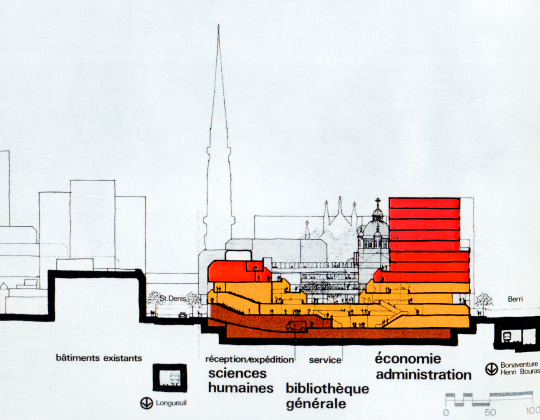
Located in a quite dense area of downtown Montréal, the two pavilions of the recently established Université du Quebéc à Montréal sit over metro lines, to which they are directly connected. A semi-underground concourse connects different educational facilities, such as cafeterias, auditoriums and class-rooms, creating dramatic spaces in correspondence of pre-existing heritage religious buildings, whose facades were incorporated in the general design.

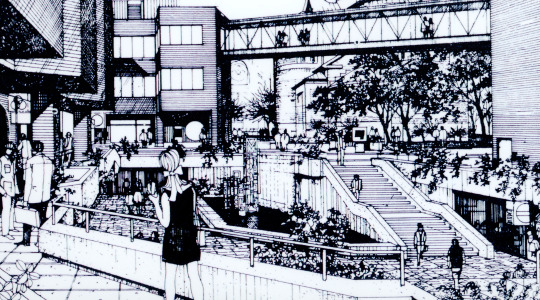
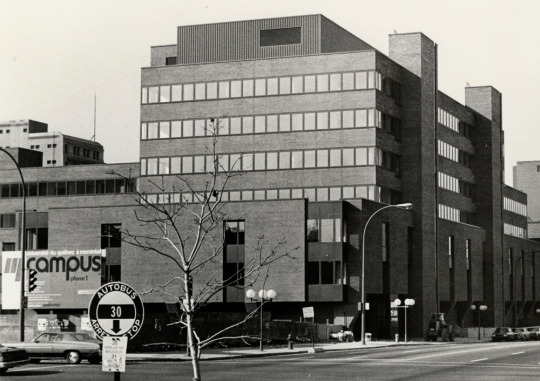




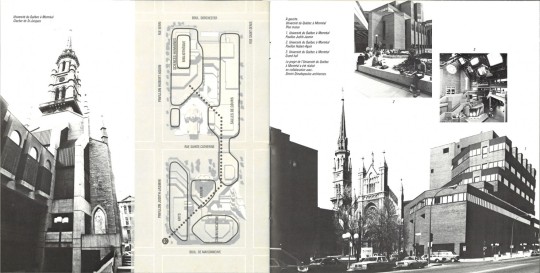
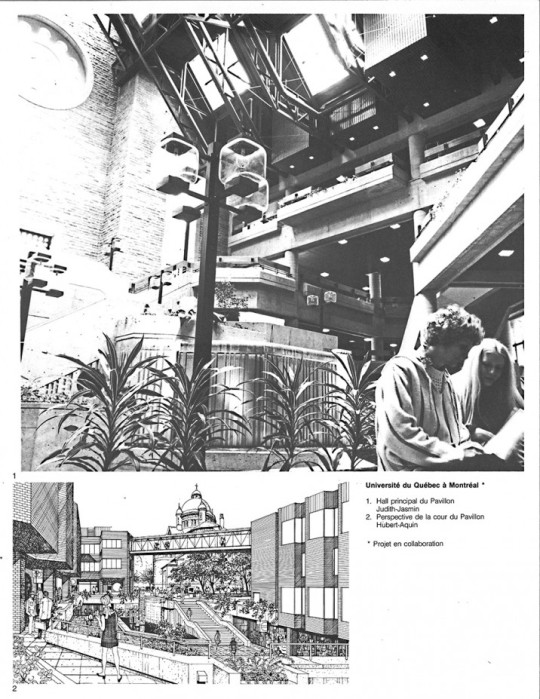
Pavillons Judith-Jasmin et Hubert-Aquin UQAM, Montréal (1974-1979) by Jodoin Pratte Lamarre and Dimitri Dimakopoulos. | Photo via © Jodoin Lamarre Pratte Architects
As a consequence of this ideological positioning, but also, of the peculiar climatic and geographical conditions of Canada, a few salient features can be read in the architecture and layout of many of the new facilities that sprouted in a very condensed period.
In particular, many projects shared the objective to interiorize within the envelope of the buildings, vast spaces for collective socialization, between students, faculty and staff. If the pastoral campus, inspired by Oxford or Cambridge was the model of the research university in the USA and of Canadian institutions between the XIX and XX centuries, one can identify in the new universities and in the additions and expansion of the existing ones of the ‘60s and ‘70s in Canada, the “galleria” as the dominant feature: a vast and climatically controlled environment for public life within an academic setting.
A very simplistic reading of such recurrent trope can just assume that as the majority of courses take place between September and May, when winter is the hardest, it is logical that indoor spaces are more important and more frequented than the lawns, courtyards, quadrants and gardens of universities in milder climates. Covered plazas, multi-storeys lobbies, expanded circulations, sky-lit concourses and indoor streets were part of an arsenal of architectural and typological tools mobilized by designers so as to accompany the surge of a new middle class of educated professionals, and to interiorize a strong idea of the “urban” inside the life of students. Such generosity was especially striking if compared to the tiny and cramped spaces of classrooms, laboratories, libraries and administrative offices of the university buildings from the first half of the XX century, often devoid of any places for informal exchange.
Still now, these vast indoor fragments of city life are extremely popular an used.
---
#FOMA 33: FIG Projects

FIG projects was founded by architects Fabrizio Gallanti and Francisca Insulza in 2003 in Santiago de Chile and is currently based in Montréal, Canada. FIG projects explores the boundaries between architecture, urban research and visual arts and promotes interdisciplinary initiatives. Wide ranging in nature, their practice extends from architectural explorations (new seat for the Literature School, Universidad Diego Portales, 2003-2005, Santiago, Chile; first prize Europan 8 competition, Kristiansand, Norway, 2006), urban studies (The Block, 2004; SARS Atlas 2006; Donde? 2006-2019), writing (Fan Club series for Interwoven magazine, 2016-2018) and curatorial projects (The World in Our Eyes, Lisbon Architecture Triennale, 2016). FIG projects work has been exhibited in different venues including Museo de Arte Contemporaneo, Santiago de Chile; exo.org, São Paulo; film + arch, Graz; Architecture and Urbanism Biennale, Shenzhen Hong Kong; Canadian Centre for Architecture, Montreal; Venice Architecture Biennale; Archivo Diseño y Arquitectura, México, Storefront Gallery for Art and Architecture, New York and Flint Free Festival, published in books such as “USE, Uncertain States of Europe” and international magazines as Domus, A+U or the Harvard Design Magazine.
484 notes
·
View notes
Text
The Good Counselor - Chapter 3
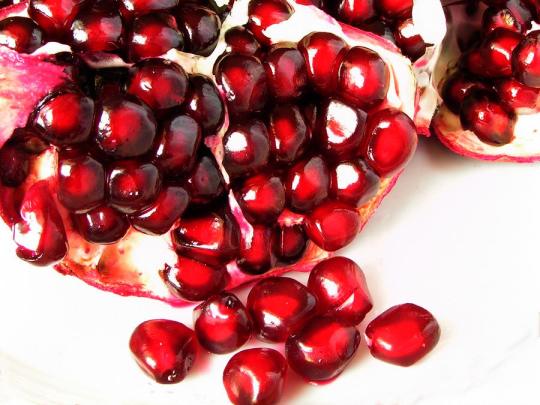

Seventy years have passed since Elysion was created, and Persephone’s efforts to conceive a child with Hades have been in vain. But a secret rite on Samothrace might bend the Fates and give them all that they have ever dreamed of, or pave a path of untold suffering.
**partial chapter**


Please visit The Good Counselor on AO3 to read in full.
Chapter 3
The ether rushed around her in a twist of silver and crimson and she emerged in the great atrium of her villa in Thesprotia. It had been abandoned for generations when Persephone had found it, and was said to be filled with the ghosts of the extinguished House of Aeolus.
Persephone knew better.
If any spirits remained, she would have wrenched them from this world already. She herself had sentenced three of that wicked family to Tartarus, Sisyphus chief among them.
Willows overhung the entire house, shielding it from the main road that led to the sea. It was modest, a short ways from the city of Cichyrus. A copse of bedraggled cypresses marked the path leading to the entrance, and thistles grew thick around the door. To the idly passing eyes of the outside world, this place was as uninhabited as it was foreboding.
But inside, it was paradise. Roses climbed the walls of the atrium garden and crocus blanketed the floor, growing through every crack in its deteriorating mosaic. A pomegranate tree— planted by Aidoneus on his first visit to their home in the world above— grew in the very center, shading a large oak stump beneath it. It was here that she found him turning a fruit over in his palm. It hadn’t come from this tree— it was only starting to blossom. This fruit came from the lands below, from their sacred grove at the entrance to Elysion. He set it down and stood.
Persephone picked up her skirts and rushed to him. He gripped her waist and she felt her feet tilt off the ground as he lifted her level with his face. Their lips met, and she sighed, melting into him. His joy and eagerness flooded into her, mellowed by tenderness and spiked with lust, warmed with relief.
And a metallic undertone of trepidation.
She eased back. “Is something troubling you?”
“No. Not yet,” he said, setting her down. “Did you take care of it?”
“He’s gone. His court is dispersed, and Minthe is by her mother’s side.” He scowled at the mention of her name. Placing the remains of the annihilated nymph by her mother’s grave had been Persephone’s idea. Hades had been less forgiving when they’d discussed it. “How is everything back home?”
“Empty as ever when you aren’t there, sweet one. How was this year’s planting?”
“The same as ever.” She hooked her arm into his and leaned in as they walked the walled garden paths. She quivered at the contact. It had been two months since her fingers had been upon his skin. She could feel his pulse and the warmth of his flesh. He smelled of raw earth, of cypress, and the cool waters— everything she missed about Chthonia. The Underworld. Her true home. Persephone glanced up and caught him chewing the inside of his lip. His mind was distant, but she knew he would eventually reveal where. She let him ruminate while she spoke. “A bit less grain to sow this year, though. She was so anxious last harvest, it affected everything.”
“Your mother needs to stop worrying after her paramour.”
“I’ve told her as much. But can you even call Triptolemus that anymore? They share the Telesterion, but more as friends than lovers. They haven’t shared a bed since—”
“I regret mentioning it,” he muttered hastily.
“Ah.” She fidgeted. “Hermes may have picked up Minoan.”
“What?”
“Unless you told him that Bellerophon broke his family’s curse and was granted a place in Elysion.”
Aidoneus gritted his teeth. “Damn him and his meddling…”
“I knew it! I knew he was lying. He denied reading your last letter to me, but how else would he know?”
“I’ll have a word with him.”
“What if that’s not the extent of it? What if he tells them about this place?”
“He won’t. I made him swear on the Styx.”
Persephone turned to him. “If the mortals know that you— that we spend time here, there will be endless interruptions. They’ll stop sowing crops. Some will leave, and the rest will build a gaudy temple. And the favors and quests of the rustic gods and hemitheoi—”
“They’ll do no such thing because Hermes will keep his mouth shut.”
“Will he?”
“He will. He takes Stygian oaths seriously.”
“How will we send letters and parcels to each other now?” A shiver rolled through her as he cupped her face with his hand.
“Perhaps I should hand-deliver them.” Aidon leaned down and gave her the lightest, slowest of kisses. His dark eyes locked onto hers as he pulled back. “Though there’s something else I’m intent on giving you presently.”
Heat rushed to her cheeks. She threw her arms around his neck and collided with him, kissing him gracelessly in return, their teeth clicking together. He chuckled low and traced her spine with his fingertips.
“Eager, are we?”
“Come,” Persephone whispered. “Let me show you what I’ve been up to this season.”
Aidoneus picked up the half pomegranate and followed her up the stairs. “A full season of sowing and still you found the time?”
“Barely enough. I vanished just after Thesmophoria to spend a few hours here alone, and I think Mother is starting to suspect—”
Aidon kissed away the name. The last person he wanted to think about right now was Demeter. He inhaled Persephone’s scent of roses and lilac, larkspur and irises. “This is my time with you. And no one else. Not Hermes, not your mother…”
Not Orpheus? Her voice rang through his head.
Aidon stopped. Did she knew where he had been? That he had spoken to the hymnist?
“His name was in your mind. Were you thinking about what Eumolpus said? Do you think…”
“I don’t want you to be disappointed again, sweet one,” he interrupted sharply. “I can’t bear it. Not after last time.”
She nodded.
He needed to distract her, or his visit to Samothrace would come pouring out unbidden. And going further down that road would only raise her hopes fruitlessly. Especially if she knew he was motivated enough to speak to Orpheus himself. “I practiced a flower while I waited for you.”
Persephone smiled. “You did?”
Their hieros gamos had not only created Elysion, but— to their mutual delight— had conferred upon each other some of their unique talents. Persephone had even called up iron from the earth seven winters ago. “Watch, sweet one.”
Aidoneus concentrated on the ground before him, and felt the beating warm life rush through him, from his feet upward. Each time he tried it he marveled. This must be what she had felt throughout her lifetime each time she created a new living thing. At first he’d worried that he would taint life itself if he tried to imitate her— that his efforts would result in a blight simply because of who he was. But they were the Gods of the Earth, he remembered, one and the same, infinitely bound and part of each other. He closed his eyes, feeling the telltale pulse in first his abdomen and rising through his chest as a bulb grew, opened, and split the ground. The stalk shot upright, bursting at the tip into a purple iris. He heard clapping and opened his eyes. Persephone exhaled softly, her hand gripping her hips. “My favorite part,” she said, “is feeling it move through you.”
“‘It’?”
“The earth, everything I have ever called up in— it’s hard to give it a name. More of a feeling. But it moves so… differently through you.”
“And you can sense every bit of… it.” He already knew the answer.
Of course I can, her voice rang, stronger this time. She turned and started strolling through the palace, showing him a centuries-old tapestry she’d found in the collapsed storage room, the vibrant ochres and deep blues sealed away and saved from the ravages of sun and wind. She picked up her skirts and climbed the stairs to the gynaikeion, giving him a glimpse of her ankles and mud stained feet. Aidon followed, listening to her describe how she’d made it into a place fit for them to sleep, to make love…
“Aidon?”
He smiled. “I was distracted. Forgive me.”
She bit coyly at her lip. “It’s similar, but just a single room. I thought black fleeces would work, but they’re hard to find in the world above. Used for sacrifices too often to…”
“To me.”
“So they seldom sell them to anyone but priests. It took me a bit of searching, but I eventually found what I needed.”
“How?”
“An agora in Locri. They were guarded at first, especially since I’m a woman. But no one asked questions after the gold came out. I suppose it helps when your husband is the richest being in the cosmos,” she said.
Aidon laughed. He looked up, and instead of the familiar dome patterned with stars, this flat ceiling was covered with tiny jasmine blooms— their growth carefully trained and arranged to reflect the summer sky. One vine wound toward the center, marking the tail of the Scorpion, and another the bow of the Lyre.
The Lyre… had she chosen this grouping of stars for a reason? He pushed it from his wandering mind. Aidon wanted to peel Persephone’s clothes off and press skin to skin, to seat himself as deeply within her as he could. But he also wanted to give her due respect as she showed him the work she’d done since they last met here.
This, he realized, was why he was creating these nervous distractions. But her breath was hitching, and he could feel her skin warming and prickling every time she glanced at him, could feel the flutter in her abdomen as though it were his own, and hear the slight tremble in her voice. His wife was being coy. Stalling. She wanted him to make the first move, the first touch. He would torture her a moment longer.
As Persephone drew closer to the fleece covered divan, his gaze rested on her hips, the pins that held her peplos taut over her skin, and the ornate girdle he had timidly left as a gift in her chamber on the fifth day he’d known her. How different it was now. Her back was turned. He plucked a seed from the pomegranate and held it under his tongue. He was as impatient for her touch as she was for his.
Aidoneus flicked his wrist, and fibulae scattered to all corners of the room. The girdle fell muffled in the heap of fabric, and Persephone gave startled gasp. He chuckled, ambling toward her as the rest of the peplum slinked from her breasts, her only adornment the flowery crown she wore in the spring and summer. Her blue-grey eyes were wide with shock and her hands instinctively covered her breasts and mons.
“It is good to know,” he said, stepping free of his own clothes, “that after all these years I can still surprise you.”
“I-I…” The blush creeping up her neck told him all he needed to know.
One piece of cloth remained, the only one not held by pins. Aidon reached behind and untied his loincloth by hand and let it drop to the floor. He gripped the half pomegranate in one hand and lifted the crown from her head with the other, then casually tossed the woven flowers aside. Aidon could feel the heat of her even through the half a pace between them. Her heels and chin lifted up so she was level with him, her eyes were lidded and her lips neared his. She relished in his guttural groan as she brushed her hand up his hip, his stomach and chest. “You’ll have to put that down.”
“Oh, will I?” He smiled and lifted the ripe fruit between them.
“What else do you plan to do with it?” She took a step back.
“Kiss me, wife, and find out.”
* * * * * *
Author's Note: Due to site Terms of Service and FOSTA-SESTA, I am no longer able to publish unabridged mature content here. To read the full scene, please continue reading The Good Counselor on AO3.
129 notes
·
View notes
Text
Walking Tour of NYC and the Skyscraper Museum
The Woolworth Building is located at 233 Broadway in Manhattan. Built by master architect Cass Gilbert and opened in 1913, this amazing structure was once the tallest building in New York City. Designed in the Neo-Gothic style, the Woolworth Building stands at 792 feet and consists of 60 stories. While the four lower levels of this structure are limestone, most of the building’s façade is glazed terra cotta. Gothic ornamentation and structural details reminiscent of elaborate European churches serve to reinforce the building’s nickname, the “Cathedral of Commerce.” Open to the public, the Woolworth Building is a must see for its stunning exterior design and its place in the history of NYC’s historical landscape.

The World Trade Center Memorial is an 8-acre park built where the Twin Towers once stood. Consisting of two, large reflective pools surrounded by waterfalls, the site is a symbol of remembrance, as the names of all those who perished in the February 1993 and September 11th terrorist attacks are honored around the perimeters of these pools. More than 400 white oak trees surround the plaza and contribute to its reflective and contemplative nature. Beneath this memorial plaza, is an underground museum with exhibits that tell the story of 9/11 and its effects on NYC and its citizens. While the Memorial is free to visit and is open to the public from 7:30 am to 9:00pm, admission to its museum varies depending on one’s age and veteran or NYPD, FDNY, and PAPD job affiliation.

The World Trade Center Transportation Hub is located in Lower Manhattan. This structure was built to replace the PATH train station that was destroyed during the September 11th terrorist attacks. Opened in 2016, the hub looks nothing like a traditional NYC train station. Its centerpiece is the Oculus, a glass and steel structure designed by Spanish architect Santiago Calatrava. Massive, bright, and visually stunning, both the exterior and interior of this contemporary station resemble the wings of a bird- fitting considering the history of the site.


The World Trade Center Palm Garden, also known as the Winter Garden Atrium, is a 10-story glass vaulted pavilion on Vesey Street in New York City. Part of the Brookfield Place office complex, the Atrium was badly damaged during the 9/11 terrorist attacks as a result of the collapse of the Twin Towers. Reconstruction of this site was completed in 2002, making it the first structure to be rebuilt after the attacks. Since its completion, the Atrium has hosted concerts, symphonies, ballets, and even a performance by the Big Apple Circus. With its 16 palm trees and several high-priced retail shops, and given its proximity to the World Trade Center Memorial and Museum, the Atrium is a must see for all.

The Skyscraper Museum is located in Battery Park City in Manhattan. Founded in 1996, this museum celebrates the architectural history of New York City and the transformation the city underwent in the design and construction of its current skyline. The museum exhibits an insightful collection of photographs, artifacts, scaled models, and information. It covers the technology, zoning law changes, and financial incentives that worked to make NYC’s landscape what it is today. For a standard admission of $5.00 and a student admission fee of $2.50, this small yet information packed museum is worth a visit for anyone interested in architectural design and development.

City Hall Park is located in Downtown Manhattan. Continuing is century-long role in civic life, the park was the site of the infamous Climate Protest on Friday, September 20, 2019. Surrounded by governmental and city municipal buildings, this usually tranquil spot was occupied by a large number of NYC’s citizens as they voiced their concerns for the future of the environment. Parading and chanting, these individuals made themselves heard by those working in the park’s surrounding area in the hopes of eliciting a response from their representatives on this important matter during the country’s upcoming UN meetings.


A walking tour of New York City is important for understanding the complex nature of its history and development, as well as its people. Oftentimes, the beauty of the city is overshadowed by the sheer size of its skyscrapers without a true appreciation for the enormous amount of time, effort, and skill that went into their planning and construction. Likewise, the resilience of New Yorkers and their love for the city can only be seen by walking among them, seeing what they have created, and hearing their voices for the future. New York City has a lot to offer, both historically and currently, and a walking tour is a must for those wanting a true NYC experience.
1 note
·
View note